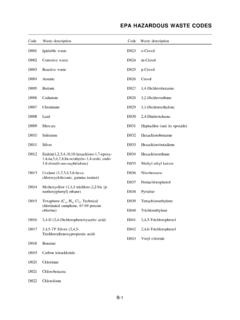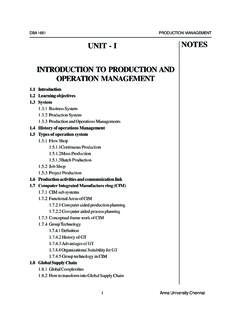Transcription of EPA HAZARDOUS WASTE CODES - GECAP
1 EPA HAZARDOUS WASTE CODESCodeWaste descriptionCodeWaste descriptionD001 Ignitable wasteD002 Corrosive wasteD003 Reactive wasteD004 ArsenicD005 BariumD006 CadmiumD007 ChromiumD008 LeadD009 MercuryD010 SeleniumD011 SilverD012 Endrin(1,2,3,4,10,10-hexachloro-1,7-epox y-1,4,4a,5,6,7,8,8a-octahydro-1,4-endo, endo-5,8-dimeth-ano-naphthalene)D013 Lindane (1,2,3,4,5,6-hexa-chlorocyclohexane, gamma isomer)D014 Methoxychlor (1,1,1-trichloro-2,2-bis [p-methoxyphenyl] ethane)D015 Toxaphene (C10 H10 Cl8, Technicalchlorinated camphene, 67-69 percentchlorine)D0162,4-D (2,4-Dichlorophenoxyacetic acid)D0172,4,5-TP Silvex (2,4,5-Trichlorophenoxypropionic acid)D018 BenzeneD019 Carbon tetrachlorideD020 ChlordaneD021 ChlorobenzeneD022 ChloroformD023o-CresolD024m-CresolD025p- CresolD026 CresolD0271,4-DichlorobenzeneD0281,2-Dic hloroethaneD0291,1-DichloroethyleneD0302 ,4-DinitrotolueneD031 Heptachlor (and its epoxide)D032 HexachlorobenzeneD033 HexachlorobutadieneD034 HexachloroethaneD035 Methyl ethyl ketoneD036 NitrobenzeneD037 PentachlorophenolD038 PyridineD039 TetrachloroethyleneD040 TrichlorethyleneD0412,4,5-Trichloropheno lD0422,4,6-TrichlorophenolD043 Vinyl chlorideB-1 EPA HAZARDOUS WASTE CODES (Continued)CodeWaste descriptionCodeWaste descriptionHAZARDOUS WASTE FROM NONSPECIFICSOURCESF001 The following spent halogenated solventsused in degreasing: Tetrachloroethylene,trichlorethylene, methylene chloride, 1,1,1-trichloroethane, carbon tetrachloride andchlorinated fluorocarbons.
2 All spent solventmixtures/blends used in degreasingcontaining, before use, a total of tenpercent or more (by volume) of one ormore of the above halogenated solvents orthose solvents listed in F002, F004, andF005; and still bottoms from the recoveryof these spent solvents and spent following spent halogenated solvents:Tetrachloroethylene, methylene chloride,trichloroethylene, 1,1,1-trichloroethane,chlorobenzene, 1,1,2-trichloro-1,2,2-trifluoroethane, ortho-dichlorobenzene,trichlorofluoromet hane, and 1,1,2,trichloroethane; all spent solventmixtures/blends containing, before use, atotal of ten percent or more (by volume) ofone or more of the above halogenatedsolvents or those solvents listed in F001,F004, and F005; and still bottoms from therecovery of these spent solvents and spentsolvent following spent non-halogenatedsolvents: Xylene, acetone, ethyl acetate,ethyl benzene, ethyl ether, methyl isobutylketone, n-butyl alcohol, cyclohexanone, andmethanol; all spent solvent mixtures/blends containing, before use, only theabove spent nonhalogenated solvents; andall spent solvent mixtures/blendscontaining, before use, one or more of theabove nonhalogenated solvents, and a totalof ten percent or more (by volume) of oneor more of those solvents listed in F001,F002, F004, and F005; and still bottomsfrom the recovery of these spent solventsand spent solvent following spent nonhalogenatedsolvents: cresols, cresylic acid, andnitrobenzene.
3 And the still bottoms from therecovery of these solvents; all spent solventmixtures/blends containing, before use, atotal of ten percent or more (by volume) ofone or more of the above nonhalogenatedsolvents or those solvents listed in F001,F002, and F005; and still bottoms from therecovery of these spent solvents and spentsolvent following spent nonhalogenatedsolvents: toluene, methyl ethyl ketone,carbon disulfide, isobutanol, pyridine,benzene, 2-ethoxyethanol, and 2-nitropropane; all spent solventmixtures/blends containing, before use, atotal of ten percent or more (by volume) ofone or more of the above nonhalogenatedsolvents or those solvents listed in F001,F002, or F004; and still bottoms from therecovery of these spent solvents and spentsolvent treatment sludges fromelectroplating operations except from thefollowing processes: (1) sulfuric acidanodizing of aluminum; (2) tin plating oncarbon steel; (3) zinc plating (segregatedbasis) on carbon steel; (4) aluminum orzinc-aluminum plating on carbon steel; (5)cleaning/stripping associated with tin, zinc,and aluminum plating on carbon steel.
4 And(6) chemical etching and milling cyanide plating bath solutions fromelectroplating bath residues from the bottom ofplating baths from electroplating operationsin which cyanides are used in the stripping and cleaning bath solutionsfrom electroplating operations in whichcyanides are used in the bath residues from oil bathsfrom metal heat treating operations inB-2 EPA HAZARDOUS WASTE CODES (Continued)CodeWaste descriptionCodeWaste descriptionwhich cyanides are used in the cyanide solutions from slat bath potcleaning from metal heat wastewater treatment sludgesfrom metal heat treating operations inwhich cyanides are used in the treatment sludges from thechemical conversion coating of aluminumexcept from zirconium phosphating inaluminum can washing when suchphosphating is an exclusive conversioncoating (except wastewater and spentcarbon from hydrogen chloridepurification) from the production ormanufacturing use (as a reactant, chemicalintermediate, or component in aformulating process ) of tri- ortetrachlorophenol or of intermediates usedto produce their pesticide derivatives.
5 (This listing does not include wastes fromthe production of hexachlorophene fromhighly purified 2,4,5-trichlorophenol.)F021 Wastes (except wastewater and spentcarbon from hydrogen chloridepurification) from the production ormanufacturing use (as a reactant, chemicalintermediate, or component in aformulating process ) of pentachlorophenol,or of intermediates used to (except wastewater and spentcarbon from hydrogen chloridepurification) from the manufacturing use(as a reactant, chemical intermediate, orcomponent in a formulating process ) oftetra-, penta-, or hexachlorobenzenes underalkaline (except wastewater and spentcarbon from hydrogen chloridepurification) from the production ofmaterials on equipment previously used forthe production or manufacturing use (as areactant, chemical intermediate, orcomponent in a formulating porcess) of tri-and tetrachlorophenols.
6 (This listing doesnot include wastes from equipment usedonly for the production or use ofhexachlorophene from highly purified2,4,5-trichlorophenol.)F024 process wastes including, but not limitedto, distillation residues, heavy ends, tars,and reactor clean-out wastes, from theproduction of certain chlorinated aliphatichydrocarbons by free radical catalyzedprocesses. These chlorinated aliphatichydrocarbons are those having carbonchain lengths ranging from one to andincluding five, with varying amounts andpositions of chlorine substitution. (Thislisting does not include wastewaters,wastewater treatment sludge, spentcatalysts, and wastes listed in or )F025 Condensed light ends, spent filters andfilter aids, and spent desiccant wastes fromthe production of certain chlorinatedaliphatic hydrocarbons, by free radicalcatalyzed processes.
7 These chlorinatedaliphatic hydrocarbons are those havingcarbon chain lengths ranging from one, toand including five, with varying amountsand positions of chlorine (except wastewater and spentcarbon from hydrogen chloridepurification) from the production ofmaterials on equipment previously used forthe manufacturing use (as a reactant,chemical intermediate, or component in aformulating process ) of tetra-, penta-, orhexachlorobenzene under unused formulations containingtri-, tetra-, or pentachlorophenol ordiscarded unused formulations containingcompounds derived from theseB-3 EPA HAZARDOUS WASTE CODES (Continued)CodeWaste descriptionCodeWaste descriptionchlorophenols. (This listing does notinclude formulations containinghexachlorophene synthesized fromprepurified 2,4,5-trichlorophenol as the solecomponent.)
8 F028 Residues resulting from the incineration orthermal treatment of soil contaminated withEPA HAZARDOUS WASTE nos. F020, F021,F022, F023, F026, and , process residuals,preservative drippage, and spentformulations from wood preservingprocesses generated at plants that currentlyuse, or have previously used,chlorophenolic formulations [exceptpotentially cross-contaminated wastes thathave had the F032 WASTE code deleted inaccordance with Section ( , thenewly promulgated equipment cleaning orreplacement standards), and where thegenerator does not not resume or initiateuse of chlorophenolic formulations]. (Thislisting does not include K001 bottomsediment sludge from the treatment ofwastewater from wood preservingprocesses that use creosote and/orpentachlorophenol.)F034 Wastewaters, process residuals,preservative drippage, and spentformulations from wood preservingprocesses generated at plants that usecreosote formulations.
9 This listing doesnot include K001 bottom sediment sludgefrom the treatment of wastewater fromwood preserving processes that usecreosote and/or , process residuals,preservative drippage, and spentformulations from wood preservingprocesses generated at plants that useinorganic preservatives containing arsenicor chromium. This listing does not includeK001 bottom sediment sludge from thetreatment of wastewater from woodpreserving processes that use creosoteand/or refinery primary oil/water/solidsseparation sludge - Any sludge generatedfrom the gravitational separation ofoil/water/solids during the storage ortreatment of process wastewaters and oilycooling wastewaters from petroleumrefineries. Such sludges include, but arenot limited to, those generated inoil/water/solids separators; tanks andimpoundments; ditches and otherconveyances; sumps; and storm water unitsreceiving dry weather flow.
10 Sludgesgenerated in storm water units that do notreceive dry weather flow, sludgesgenerated in aggressive biological treatmentunits as defined in (b)(2)(including sludges generated inone or more additional units afterwastewaters have been treated inaggressive biological treatment units), andK051 wastes are exempted from HAZARDOUS WASTE CODES (Continued)CodeWaste descriptionCodeWaste descriptionF038 Petroleum refinery secondary (emulsified)oil/water/solids separation sludge - Anysludge and/or float generated from thephysical and/or chemical separation ofoil/water/solids in process wastewaters andoily cooling wastewaters from petroleumrefineries. Such wastes include, but arenot limited to, all sludges and floatsgenerated in induced air flotation (IAF)units, tanks and impoundments, and allsludges generated in DAF units.







